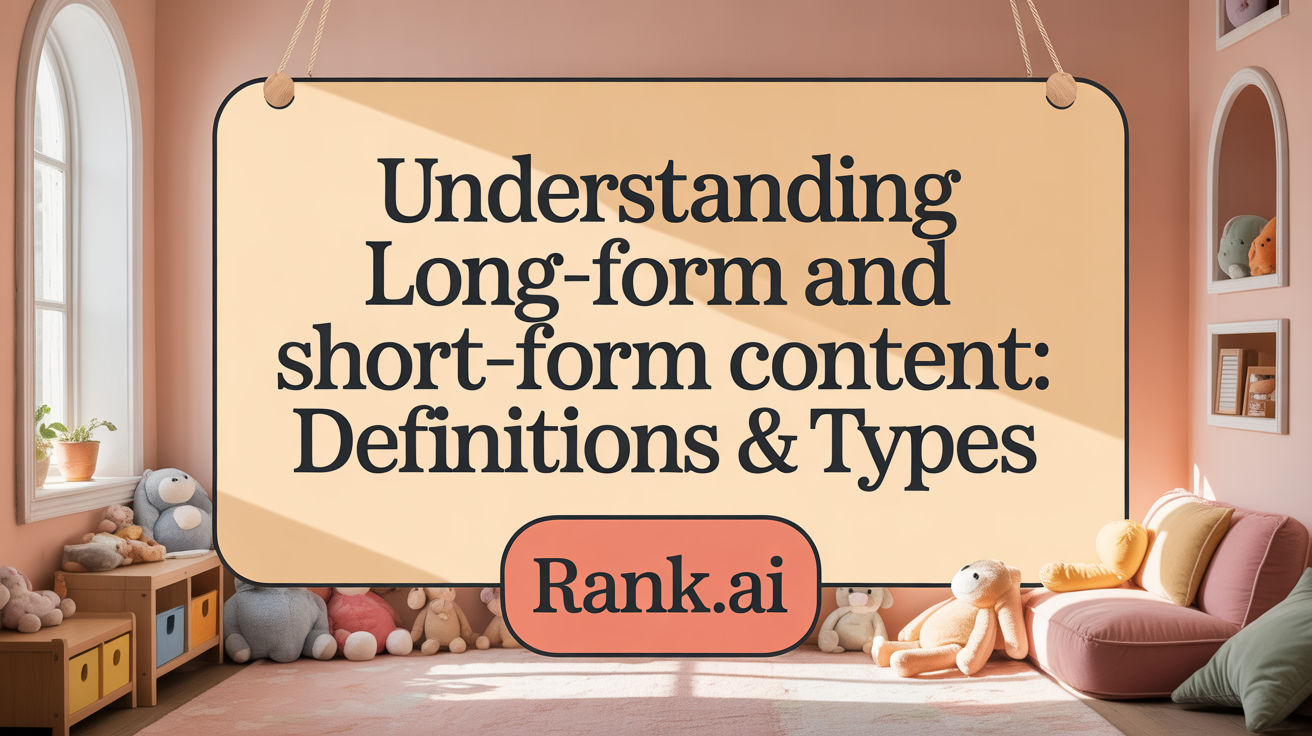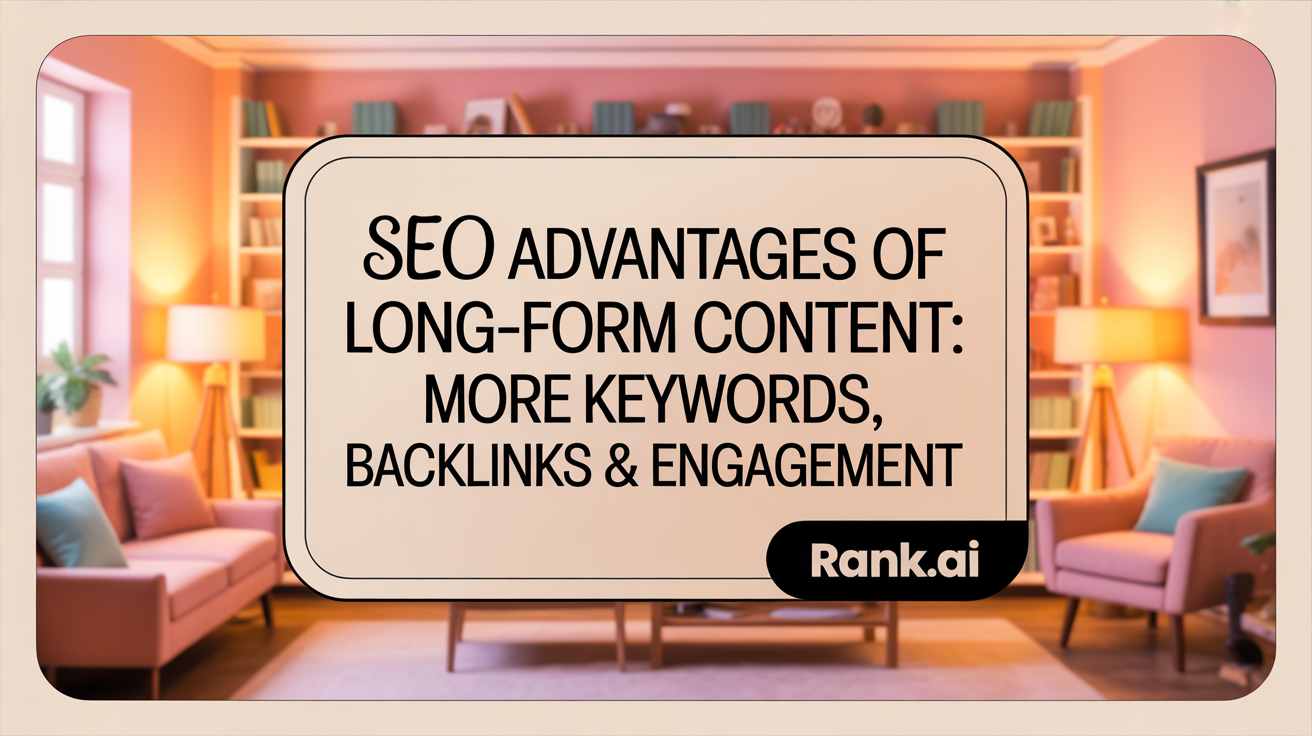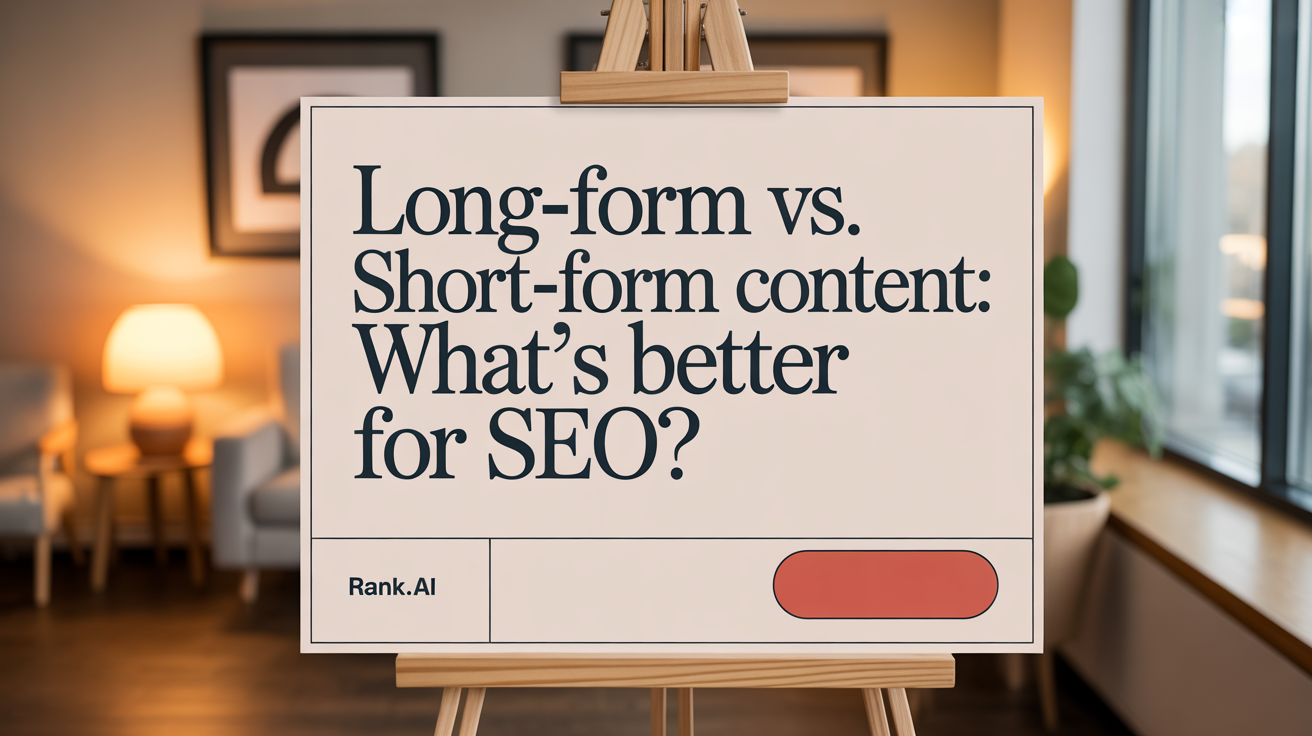Understanding Content Length in SEO
In the digital marketing landscape, content length plays a pivotal role in influencing search engine rankings and user engagement. Marketers and SEO professionals often face the question: should they invest time and resources into long-form content or opt for the quick impact of short-form content? This article explores the SEO value of both content types, examining their benefits, drawbacks, and strategic roles to guide better content strategy decisions.
Defining Long-Form and Short-Form Content

What is long-form content?
Long-form content generally refers to detailed and comprehensive material that exceeds 1,200 words. It often includes in-depth blog articles, white papers, e-books, case studies, and extensive guides. These pieces aim to thoroughly explore complex topics, answer detailed questions, and provide significant value to the reader.
What is short-form content?
Short-form content is typically under 1,000 words, designed to deliver quick, digestible messages. It includes social media posts, brief blog articles, emails, infographics, videos under three minutes, and memes. Short-form content aims for rapid engagement with audiences, especially on mobile and social platforms.
Types of content included in each category
- Long-form content: Blog posts (over 1,200 words), white papers, e-books, detailed tutorials, case studies, webinars, and pillar pages.
- Short-form content: Tweets, Instagram or TikTok videos, short blog snippets, social media posts, and quick emails.
Media formats associated with both types
- Long-form media: Long videos (such as webinars), podcasts, in-depth articles, and comprehensive white papers.
- Short-form media: Short videos, images, reels, TikToks, memes, and brief posts.
Understanding these distinctions helps marketers choose the right format to meet their goals—whether building authority with long, detailed content or engaging audiences quickly with short, catchy messages.
SEO Benefits of Long-Form Content Compared to Short-Form
 Long-form content, typically exceeding 1,200 words, provides several advantages for SEO over short-form pieces. One of its primary benefits is the enhanced ability to cover a broader range of keywords and semantic phrases within a single article. This keyword diversity helps the content rank for multiple search queries, increasing visibility.
Long-form content, typically exceeding 1,200 words, provides several advantages for SEO over short-form pieces. One of its primary benefits is the enhanced ability to cover a broader range of keywords and semantic phrases within a single article. This keyword diversity helps the content rank for multiple search queries, increasing visibility.
Moreover, long articles allow for comprehensive coverage of complex topics. Search engines favor in-depth, valuable content that thoroughly addresses user intent. As a result, long-form content often establishes greater authority and trustworthiness, which are critical factors for ranking highly.
Another significant advantage is the tendency to generate more backlinks and social shares. Detailed, well-researched content tends to be referenced and shared more frequently, boosting domain authority and improving search rankings. The increased engagement typically leads to more time spent on the page, lowering bounce rates and signaling quality to search engines.
A well-structured long-form article keeps visitors engaged longer, encouraging them to explore related pages or convert into leads. This increased user engagement aligns with SEO strategies aimed at improving dwell time and reducing bounce rates.
In summary, the thorough nature of long-form content makes it more effective for SEO. It supports a broader keyword strategy, builds authority, attracts backlinks, and enhances user engagement, all vital for achieving better search engine results compared to short-form content.
Comparing SEO Performance: Long-Form vs. Short-Form Content

Does long-form content provide better SEO results than short-form content?
Long-form content generally achieves better SEO results compared to short-form content. This is because longer articles, typically exceeding 1,200 words, allow for a more comprehensive coverage of topics. They include a greater number of keywords, internal links, and valuable information that search engines favor.
Longer content also tends to attract more backlinks, which are crucial for improving domain authority and search rankings. Research from Backlinko shows that articles over 3,000 words generate approximately 21% more traffic, 24% more shares, and 75% more backlinks. This increased engagement and backlink activity reinforce its SEO potential.
Furthermore, long-form content enhances user engagement by increasing the time visitors spend on a page, which search engines interpret as a sign of valuable content. It also provides deeper insights, building trust and authority in the industry.
However, the effectiveness of long versus short content depends on factors like audience preferences, content relevance, and execution quality. Well-structured, relevant short articles can still perform well, especially for quick answers or updates.
In summary, while long-form content often outperforms short-form in SEO metrics due to its depth, relevance, and backlink potential, success ultimately depends on the strategic focus on quality, relevance, and audience engagement.
Search engine ranking trends
Search engines tend to prioritize comprehensive, high-quality content. Data indicates that articles averaging around 1,447 words, which is typical for Google's first page results, have an advantage. Longer content aligns with search intent for in-depth answers and is more likely to rank higher.
Backlink generation
Long-form content earns significantly more backlinks. In contrast, short-form content, while easier and quicker to produce, generally garners fewer backlinks, limiting its SEO impact. This backlink advantage contributes to higher search rankings for long articles.
User time on page metrics
Extended content tends to keep visitors engaged longer, increasing dwell time—a positive signal for SEO. Conversely, short content is designed for quick consumption and may not sustain prolonged engagement.
Industry case studies illustrating effectiveness
Multiple industry case studies reveal that long-form content not only improves search rankings but also boosts traffic and conversions. For example, comprehensive guides and detailed case studies consistently outperform shorter posts in attracting backlinks, shares, and organic traffic.
| Aspect | Short-Form Content | Long-Form Content | Additional Details |
|---|---|---|---|
| Typical word count | Under 1,000 words | 1,200 words or more | Longer articles tend to rank higher on Google and attract more backlinks. |
| SEO potential | Limited, good for quick updates | High, supports keyword saturation and internal linking | Better for ranking, engagement, and authority building. |
| User engagement | Focused, quick consumption | Longer dwell time and in-depth reading | Impacts search rankings positively. |
| Backlink opportunities | Generally fewer | More due to comprehensive coverage | Essential for higher SERP rankings. |
| Content production | Fast, cost-effective | Time-consuming, resource intensive | Requires planning but yields higher SEO benefits. |
Overall, incorporating longer, comprehensive content into your strategy can significantly enhance SEO outcomes, bolster authority, and foster trust with your audience.
User Engagement and Content Length: Balancing Depth and Accessibility
How do different content lengths influence user engagement and SEO performance?
Content length significantly affects how users interact with your website and how well your pages perform in search engine rankings. Longer articles—generally over 1,200 words—offer comprehensive coverage of a topic. This depth encourages visitors to stay longer on the page, boosting dwell time, which is a positive signal for search engines. Additionally, in-depth content can naturally include more keywords, related links, and authoritative references, helping improve SEO rankings.
Shorter content, typically under 1,000 words, caters to an audience seeking quick answers. Such content is often easier to consume on mobile devices and can be produced and updated rapidly. While it may generate higher click-through rates and social shares in the short term, it generally offers limited scope for keyword optimization and backlink acquisition.
Ultimately, both content types serve valuable roles. Long-form content helps establish authority, attract backlinks, and improve search rankings. Short-form content enhances engagement, increases posting frequency, and fulfills quick informational needs. The optimal strategy combines these formats, aligning content length with specific audience preferences and search intent to maximize engagement and SEO impact.
Strategic Advantages and Drawbacks of Long-Form Content in Digital Marketing

What are the strategic advantages and drawbacks of long-form content in digital marketing?
Long-form content, typically exceeding 1,200 words, plays a crucial role in digital marketing strategies. Its primary advantage lies in boosting search engine optimization (SEO). Due to its detailed nature, long-form content allows for extensive keyword usage, internal linking, and comprehensive coverage of topics, making it more discoverable and authoritative in search rankings.
Furthermore, long-form content helps establish a brand as an industry leader. Through in-depth articles, white papers, guides, and case studies, it builds trust with audiences and nurtures leads effectively. This type of content provides significant value, encouraging readers to spend more time on a website, which positively impacts rankings and engagement metrics.
Another benefit is the ability to create a rich content library. Cornerstone content pieces serve as foundational references that can be repurposed across blogs, social media, videos, and other formats, ensuring sustained visibility and brand authority.
However, long-form content also presents challenges. Producing high-quality, detailed content demanding substantial time and financial resources can be a barrier for many brands. It requires careful planning, research, and editing to avoid losing reader interest, especially if the content is poorly structured or overly verbose.
Additionally, there's a risk of reader fatigue. Lengthy articles or videos might overwhelm or discourage casual viewers. Therefore, integrating engaging elements such as multimedia, clear headings, and concise summaries is vital to maintaining audience interest.
Incorporating long-form content into a balanced strategy involves aligning it with audience preferences and platform nuances. When executed well, it amplifies authority, supports SEO, and nurtures meaningful relationships. Conversely, mismanagement can lead to wasted resources and diminished engagement.
In summary, the strategic advantages of long-form content—enhanced SEO, authority building, and content longevity—must be weighed against the higher costs, time commitment, and potential for audience disengagement if not properly managed. Striking the right balance between comprehensive long-form pieces and engaging short content is fundamental to a successful digital marketing approach.
More about this topic: Search queries like "Advantages and disadvantages of producing long form content" further explore these concepts and provide insights into optimizing content strategies for diverse goals.
Best Practices for Creating Long-Form and Short-Form Content to Enhance SEO
How can research and organization techniques improve long-form content?
Creating effective long-form content starts with thorough research. This involves gathering relevant data, authoritative opinions, and up-to-date statistics to build credibility. Once the research phase is complete, organizing information into clear, logical structures like headings and sub-sections helps the reader navigate complex topics. In addition, using tools such as outlines and content planners can ensure the content flows cohesively, covering all necessary angles comprehensively. Incorporating multimedia elements like images, videos, and infographics enhances readability and authority, making the content more engaging.
What should be the focus in short-form content regarding engagement and calls to action?
Short-form content aims to deliver quick, impactful messages, so clarity and focus are crucial. Hook the audience early with strong headlines or visuals and promote immediate action with clear calls to action (CTAs). Whether it's liking, sharing, or clicking a link, every piece should prioritize user engagement. To boost interaction, include relevant multimedia like images, GIFs, or short videos that resonate with the audience. Tailoring messages to specific platforms—like concise posts for Twitter or engaging reels for Instagram—ensures relevance and effectiveness.
How can keyword optimization be maintained naturally across content?
Effective SEO content balances keyword use with natural language. Conduct keyword research to find relevant terms and phrases, then incorporate them seamlessly into headings, subheadings, and body text. Avoid keyword stuffing by focusing on variations and related terms, which enhances readability and avoids penalties. Use synonyms and long-tail keywords to diversify keyword presence while maintaining a natural writing flow.
Why is content repurposing and platform tailoring vital?
Repurposing content allows maximizing its value across multiple formats—turning a detailed blog into infographics, videos, or social media snippets. This broadens reach and reinforces messaging. Tailoring content to platform specifics—such as shorter, punchier posts for social media, detailed guides for blogs, and engaging videos for YouTube—ensures better engagement and aligns with audience preferences.
How can performance measurement and iterative improvements boost content effectiveness?
Using analytics tools like Google Analytics and platform insights helps track how content performs in terms of traffic, engagement, and conversions. Regularly reviewing these metrics reveals what resonates with the audience. Based on data, refine content strategies, update outdated information, and optimize headlines or CTAs. Continuous testing and iteration ensure that both long- and short-form content remain effective and aligned with marketing objectives.
By mastering research, organization, natural keyword use, platform adaptation, and ongoing analysis, content creators can significantly enhance their SEO performance and audience engagement. Balancing detailed long-form articles with concise, impactful short-form pieces maximizes visibility and builds authority in any niche.
How Content Length Shapes Content Marketing Strategies and Media Consumption
How does content length affect content marketing strategies and media consumption trends?
Content length plays a crucial role in shaping how brands develop their marketing strategies and how audiences consume media today. Longer articles, typically exceeding 1,200 words, are favored for deep dives into complex topics. They help establish authority, improve search engine rankings, and earn more backlinks, which in turn boost overall SEO performance. Data from industry research indicates that content around 2,100 to 2,400 words often performs the best organically, attracting more traffic and shares.
On the other hand, short-form content—usually under 1,000 words or less than a minute for videos—is optimized for quick consumption. These pieces are ideal for mobile users who prefer bite-sized information, such as Tweets, Instagram reels, or brief blog posts. They excel in capturing immediate attention, encouraging social sharing, and boosting engagement in fast-paced digital environments.
Video content exemplifies this division. Short videos, typically less than two minutes, are highly effective for quick messaging and rapid engagement, especially on platforms like TikTok and Instagram. Longer videos, often 10 minutes or more, are suitable for in-depth tutorials, webinars, and podcasts. Longer videos can establish authority and foster deeper viewer trust if they manage to maintain attention.
Balancing content length with quality and marketing goals is vital. While short content increases reach and frequency, long-form content enhances authority, SEO, and conversion rates. Ultimately, a strategic mix—tailored to platform preferences, target audience behaviors, and the nature of the message—can deliver both immediate engagement and sustained industry leadership. This dynamic approach ensures brands meet evolving media consumption trends efficiently.
The Role of Long-Form Content in Establishing Authority and Trust

Building brand reputation and thought leadership
Long-form content plays a crucial role in establishing a brand as a leader in its industry. By providing in-depth, detailed information, companies demonstrate their expertise and commitment to delivering value. Such comprehensive content not only attracts more traffic but also encourages sharing and backlinks, which enhance the brand's authority.
Use of data, research, and expert insights
Incorporating data, research findings, and insights from industry experts makes long-form content more credible and trustworthy. This type of content often includes statistics, case studies, and quotes that reinforce key messages, helping to build trust with the audience. When readers see well-researched, factual information, they are more likely to rely on the brand as a reliable source.
Lead nurturing and conversion improvements
Long-form articles and guides have been shown to boost conversion rates by over 30%. By thoroughly answering questions, explaining complex topics, and providing detailed solutions, long-form content nurtures potential leads through the sales funnel. It also encourages visitors to spend more time on the website, increasing the likelihood of taking desired actions, such as subscribing or making a purchase.
Creating a comprehensive content library
Producing high-quality long-form content allows organizations to develop a rich content library. This collection serves multiple purposes including ongoing education for clients, resources for sales teams, and SEO advantage due to increased keyword coverage and internal linking. Over time, this library enhances brand credibility and supports sustained growth.
In summary, long-form content significantly contributes to building a strong, authoritative brand presence. Its detailed nature, combined with strategic use of data and insights, fosters trust, nurtures leads, and creates a valuable repository of knowledge that benefits both audiences and businesses.
Short-Form Content’s Strengths: Quick Engagement and Shareability
Ease of consumption and mobile optimization
Short-form content, often under 1,000 words or less, is designed for quick and easy consumption. It is highly suited for mobile devices, allowing users to grasp messages in just a few seconds. This makes it ideal for capturing attention among busy audiences who scroll through feeds rapidly.
Social media effectiveness and virality
Platforms like TikTok, Instagram Reels, and Twitter have popularized short-form content, emphasizing shareability and rapid engagement. Because it’s quick to consume and easy to share, short content often goes viral, increasing reach and brand visibility.
Cost and time efficiency in production
Creating short-form content requires fewer resources and less time compared to long-form pieces. It enables brands to produce frequent, snackable updates, which keeps their online presence active and engaging without significant investment.
Complementary role alongside long-form content
While short-form content is excellent for immediate engagement and quick updates, it works best when combined with long-form content. The latter provides depth and authority, with short-form serving as a teaser or promotional tool to direct audiences to more comprehensive resources.
Mixed Content Strategies: Combining Long-Form and Short-Form for Optimal SEO
How to tailor your content mix to your audience and platform
A successful content strategy balances long-form and short-form content, aligning with audience preferences and platform nuances. Short-form content, typically under 1,000 words, is ideal for quick engagement on social media channels like TikTok, Instagram, and Twitter. It captures attention swiftly and encourages rapid sharing.
In contrast, long-form content over 1,200 words provides in-depth exploration of complex topics, establishing authority and enhancing SEO. These comprehensive pieces, such as detailed blog posts, white papers, and webinars, are suited for platforms like your website or LinkedIn where audiences seek thorough information.
Understanding your audience’s consumption habits and preferences allows you to customize your content mix effectively. Younger audiences may favor bite-sized videos and social media posts, while industry professionals could prioritize in-depth guides and research reports.
Leveraging short form for immediate engagement
Short-form content excels in capturing attention quickly and prompting immediate actions like clicking, sharing, or commenting. Its quick turnaround makes it perfect for seasonal campaigns, product launches, or time-sensitive promotions.
To maximize impact:
- Use strong visuals and compelling headlines.
- Incorporate trending topics and hashtags.
- Include clear calls-to-action (CTAs) to drive user interaction.
Platforms such as TikTok, Instagram Reels, and Twitter reward short, engaging videos and posts that can go viral, thereby increasing brand visibility and broad reach.
Using long form for depth and authority
In-depth content demonstrates expertise, fosters trust, and supports SEO strategies by allowing for rich keyword inclusion and backlink opportunities. Examples include comprehensive guides, case studies, and webinars that provide valuable information and help nurture leads.
Long-form content also improves website engagement metrics, like increased time on page and page views, which search engines interpret as signals of high-quality content.
Key benefits include:
- Establishing brand authority.
- Generating backlinks.
- Supporting complex user inquiries.
Continuous testing and analytics-driven adjustments
An effective strategy involves ongoing testing and analysis. Use tools like Google Analytics, SEMrush, or Ahrefs to monitor how different content formats perform.
Track metrics such as:
- Traffic and bounce rates.
- Engagement levels.
- Conversion rates.
- Backlinks and shares.
Adjust your content mix based on these insights, ensuring you prioritize formats that deliver the highest ROI. Combining data-driven decisions with creative flexibility allows brands to optimize their content strategy continually.
In conclusion, integrating long- and short-form content tailored to your audience and platform not only maximizes reach but also enhances your SEO and authority. Continual evaluation and optimization are essential for sustained success in a dynamic digital landscape.
Beyond Word Counts: Quality and Relevance as SEO Pillars
What is Google’s stance on content length and ranking?
Google does not set explicit requirements for how long a piece of content should be to rank well. However, research shows that longer, comprehensive content tends to perform better in search results. Data from Backlinko indicates that the average top-ranking page contains around 1,447 words, suggesting that Google favors thorough coverage of topics. Search engines aim to rank content that thoroughly addresses user queries, and quality often correlates with increased length because it provides more detailed insights and better answers.
Why are user intent and content value crucial?
The main factors influencing content ranking are user intent and the value the content offers. Google's algorithms prioritize content that matches what users are searching for, whether they seek quick answers or in-depth information. High-quality content that aligns with search intent satisfies user needs, encourages longer dwell times, and earns more backlinks—vital for SEO success. It’s not just about hitting a word count but ensuring the material is relevant, informative, and valuable.
How can content creators avoid padding and forcing length?
Adding unnecessary filler just to inflate word count can harm both readability and rankings. Instead, focus on delivering meaningful content that genuinely answers questions and provides insights. Use data, examples, and expert opinions to enrich your material naturally. Integrating relevant keywords thoughtfully and linking to related resources not only enhances depth but also keeps the content engaging. Quality over quantity is essential for building authority and maintaining audience trust.
What about readability and alignment with search intent?
Ensuring content is well-structured with clear headings, short paragraphs, and relevant visuals improves readability. When content aligns with user search intent—whether informational, transactional, or navigational—readers find it more useful, increasing engagement. Regularly updating and refining content based on analytics and feedback helps maintain relevance. Ultimately, balancing depth with clarity and purpose leads to better SEO outcomes and a more satisfied audience.
Choosing the Right Content Length for SEO Success
The SEO value of content is influenced by multiple factors beyond sheer word count. Long-form content provides significant advantages in building authority, driving backlinks, and supporting comprehensive topic coverage that aligns with search intent. Conversely, short-form content excels at engaging audiences rapidly, enhancing shareability, and meeting mobile consumption habits. Ultimately, the best SEO strategies integrate both formats thoughtfully, balancing quality, audience preferences, and digital marketing goals. By understanding and leveraging the distinctive benefits of long-form and short-form content, marketers can create a dynamic content ecosystem that maximizes visibility, engagement, and conversions in an ever-evolving online landscape.
References
- Long Form vs Short Form Content: Which Should You Create?
- Long Form vs. Short Form Content: Which Is Better For Your Business?
- Case Study: Long-Form Content vs Short-Form Content - THAT Blog
- Short form vs long form content: Which do audiences prefer?
- What You Need to Know About Long-Form Content in 2024
- Long Form vs Short Form for SEO — Does Length Matter? - Vazoola
- Short-form Content vs. Long-form Content: Which is best for | Scripted
- Why Short Form Content is King - Digital Brew



